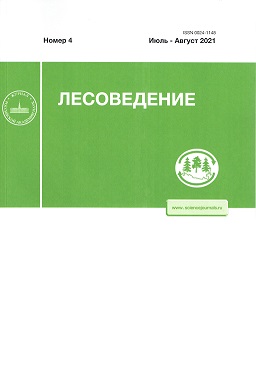ISSN: 0024-1148 Russian Journal of Forest Science. 2016, No. 3, pp. 199-208
THE EFFECT OF SLOPE PROCESSES ON DYNAMIC BALANCE OF FLORISTIC DIVERSITY OF ALDER AND ELM FORESTS
S. Y. Popov
Faculty of Biology, Lomonosov Moscow State University (MSU)
Leninskie Gory 1 bldg. 12, Moscow, 119991, Russia
E-mail: s_yu_popov@rambler.ru
Received 2 March 2015
Alder and elm forests of Ulmus laevis, U. glabra, Alnus incana grow on the slopes of the river valleys with exposed carbonaceous substrate in European part of Russia. They occur in highly similar ecotopes and have close floristic and phytocoenotic traits. Their dynamics is continuous cyclic changes from domination of alder to elm due to slope processes. Our study revealed mosaic vegetation patterns associated with topography. Continuous slope processes supported regeneration of grey alder under elm canopy and vice versa. Regeneration of spruce was controlled by the soil type and stand composition.
- Keywords: alder and elm forest, slope processes, ecotopic attribution, cyclic regeneration, eco-coenotic group.
REFERENCES
1. Alexseev Y.E., Dzama E.D., Ershova E.G., Zhmylev P.Y., Karpukhina E.A., Terebova A.S., Vyazovniki i il'movniki Evropeiskoi ravniny: problemy nastoyashchego i proshlogo (Ulmus laevis and U. glabra forests of the European plain: problems of the present and the past), Byulleten' Moskovskogo obshchestva ispytatelei prirody. Otdel biologicheskii, 2013, Vol. 118, No. 2, pp. 36-47.
2. Chertov O.G., Ekologiya lesnykh zemel': pochvenno-ekologicheskie issledovaniya lesnykh mestoobitanii (Environment of forested lands: soil and environmental studies at forest sites), Leningrad: Nauka, 1981, 192 p.
3. Opredelenie tipov gumusa lesnykh pochv: metodicheskie ukazaniya (Guidelines to recognition of humus types in forest soils), 1974.
4. Czerepanov S.K., Vascular plants of Russia and adjacent states (the former USSR), Cambridge: Cambridge university press, 1995, 516 p.
5. Danilova M.M., Lesa s shirokolistvennymi porodami v usloviyakh Permskoi oblasti (Woodlands of bradleaf species in Perm Oblast environment), Uchenye zapiski Permskogo gosudarstvennogo universiteta, 1962, Vol. 22, No. 4, pp. 62-70.
6. Duchaufour P., Précis de pédologie. L'évolution des sols, Moscow: Progress, 1970, 591 p.
7. Dylis V.N., Zhukova V.M., Zolotokrylin A.N., Kholopova L.B., Vyazovniki - novaya lesnaya formatsiya Podmoskov'ya (Elm forests: the new forest formation in Moscow Region), Lesovedenie, 1981, No. 3, pp. 12-20.
8. Egorov V.V., Fridland V.M., Rozov N.N., Nosin V.A., Friev T.A., Klassifikatsiya i diagnostika pochv SSSR (Classification and diagnostics of the soils of USSR), Moscow: Kolos, 1977, 224 p.
9. Gribova S.A., Isachenko T.I., Lavrenko E.M., Rastitel'nost' evropeiskoi chasti SSSR (The vegetation of the European part of the USSR), Leningrad: Nauka, 1980, 429 p.
10. Khens L., Bun E.K., Solntsev V.N., Sinitsin M.G., Rusanov A.V., Kostromskoe Zavolzh'e: priroda i chelovek. Ekologo-sotsial'nyi ocherk (Kostroma Transvolga region: human and environment. Socioecological notes.), Moscow: Izd-vo IPEE RAN, 2001, 200 p.
11. Khoroshev A.V., Nemchinova A.V., Avdanin V.O., Landshafty i ekologicheskaya set' Kostromskoi oblasti (Landscapes and ecological network in Kostroma Oblast), Kostroma: Izd-vo KGU, 2013, 426 p.
12. Lazareva N.S., Preobrazhenskaya E.S., Popov S.Y., Flora okrestnostei Kostromskoi taezhnoi nauchno-opytnoi stantsii IPEE RAN i Manturovskogo uchastka zapovednika ''Kologrivskii les'' (Flora of neighbourhoods of Kostroma taiga research station, IPEE RAN and Manturovo extension of Kologriv Forest Reserve), Moscow - Saint Petersburg: Intermediya, 2012, 84 p.
13. Nitsenko S.F., Listvennye lesa, melkoles'ya i kustarniki Leningradskoi oblasti. Sel'skokhozyaistvennyi fond (Deciduous forests, scrubs and shrubs in Leningrad Oblast. Agricultural fund), Vestnik Leningradskogo universiteta. Seriya 3: Biologiya, 1956, No. 4, pp. 31-41.
14. Popov S.Y., Istoriya i sovremennoe sostoyanie lesnoi rastitel'nosti byvshego Kologrivskogo uezda Kostromskoi gubernii (History and current state of forest vegetation of the former Kologriv uyezd of Kostroma guberniya), Botanicheskii zhurnal, 2010, Vol. 95, No. 8, pp. 1116-1125.
15. Smirnova O.V., Khanina L.G., Smirnov V.E., Ekologotsenoticheskie gruppy v rastitel'nom pokrove lesnogo poyasa Vostochnoi Evropy (Eco-coenotic groups in the plant cover of forest zone in Eastern Europe), In: Vostochnoevropeiskie lesa: istoriya v golotsene i sovremennost' (Eastern European forest in the Holocene and modern history), Moscow: Nauka, 2004, Vol. 1, pp. 165-175 (479 p.).
16. Vasil'evskaya V.D., Pochvy yuzhnotaezhnogo Zavolzh'ya v predelakh Kostromskoi oblasti (Soils of the boreal domain in Transvolga within Kostroma Oblast), In: Struktura i dinamika ekosistem yuzhnotaezhnogo Zavolzh'ya (Structure and dynamics of ecosystems in boreal domain in Transvolga), Moscow: Izd-vo IEMEZh, 1989, pp. 5-35 (188 p.).
17. Vasilevich V.I., Bibikova T.V., Shirokolistvennye lesa Severo-Zapada Evropeiskoi Rossii. II. Tipy klenovykh, yasenevykh i il'movykh lesov (Broadleaved forests in North-West of European part of Russia. 2. Types of acer, ash and elm forests), Botanicheskii zhurnal, 2002, Vol. 87, No. 2, pp. 48-60.
18. Yarmishko V.T., Lyanguzova I.V., Metody izucheniya lesnykh soobshchestv (Methods in the forest communities studies), Saint-Petersburg: NIIKhimii SPbGU, 2002, 240 p.

